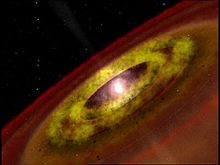- T Tauri star
-
Star formation 
Interstellar medium
Molecular cloud
Bok globule
Dark nebula
Young stellar object
Protostar
T Tauri star
Herbig Ae/Be stars
Nebular hypothesisObject classes Herbig–Haro object Theoretical concepts Initial mass function
Jeans instability
Kelvin–Helmholtz mechanism
 Star portal
Star portal
T Tauri stars (TTS) are a class of variable stars named after their prototype – T Tauri. They are found near molecular clouds and identified by their optical variability and strong chromospheric lines.
Characteristics
T Tauri stars are pre–main sequence stars – the youngest visible F, G, K, M spectral type stars (<2 Solar mass). Their surface temperatures are similar to those of main sequence stars of the same mass, but they are significantly more luminous because their radii are larger. Their central temperatures are too low for hydrogen fusion. Instead, they are powered by gravitational energy released as the stars contract towards the main sequence, which they reach after about 100 million years. They typically rotate with a period between one and twelve days, compared to a month for the Sun, and are very active and variable.
There is evidence of large areas of starspot coverage, and they have intense and variable X-ray and radio emissions (approximately 1000 times that of the Sun). Many have extremely powerful stellar winds. Another source of brightness variability are clumps (protoplanets and planetesimals) in the disk surrounding T Tauri stars.
Their spectra show a higher lithium abundance than the Sun and other main sequence stars because lithium is destroyed at temperatures above 2,500,000 K. From a study of lithium abundances in 53 T Tauri stars, it has been found that lithium depletion varies strongly with size, suggesting that "lithium burning" by the P-P chain, during the last highly convective and unstable stages during the later pre–main sequence phase of the Hayashi contraction may be one of the main sources of energy for T Tauri stars. Rapid rotation tends to improve mixing and increase the transport of lithium into deeper layers where it is destroyed. T Tauri stars generally increase their rotation rates as they age, through contraction and spin-up, as they conserve angular momentum. This causes an increased rate of lithium loss with age. Lithium burning will also increase with higher temperatures and mass, and will last for at most a little over 100 million years.
The P-P chain for Lithium burning is as follows
It will not occur in stars with less than sixty times the mass of Jupiter. In this way, the rate of lithium depletion can be used to calculate the age of the star.
 Protoplanetary discs in the Orion Nebula
Protoplanetary discs in the Orion Nebula
Roughly half of T Tauri stars have circumstellar disks, which in this case are called protoplanetary discs because they are probably the progenitors of planetary systems like the solar system. Circumstellar discs are estimated to dissipate on timescales of up to 10 million years. Most T Tauri stars are in binary star systems. In various stages of their life, they are called Young Stellar Objects (YSOs). It is thought that the active magnetic fields and strong solar wind of Alfvén waves of T Tauri stars are one means by which angular momentum gets transferred from the star to the protoplanetary disc. A hypothesised T Tauri stage for our Solar System would be one means by which the angular momentum of the contracting Sun was transferred to the protoplanetary disc and hence, eventually to the planets, resulting in the theory that before our own Sun matured, it was once a T Tauri star.
Analogs of T Tauri stars in the higher mass range (2–8 solar masses)—A and B spectral type pre–main sequence stars, are called Herbig Ae/Be stars. More massive (>8 Solar mass) stars in pre–main sequence stage are not observed, because they evolve very quickly: when they become visible (i.e. disperses surrounding circumstellar gas and dust cloud), the hydrogen in the center is already burning and they are main sequence objects.
See also
- Orion variables
- Weak-lined T Tauri star
References
- Appenzeller, Immo; Mundt, Reinhard (1989). "T Tauri Stars". Aston.Astrophys.Rev. 1 (3–4): 291–334. Bibcode 1989A&ARv...1..291A. doi:10.1007/BF00873081.
- Discussion of V471 Tauri observations and general T-Tauri properties, Frederick M. Walter, Stony Brook University, April 2004
- An empirical criterion to classify T Tauri stars and substellar analogs using low-resolution optical spectroscopy, David Barrado y Navascues, 2003
Categories:- Star types
- T Tauri stars
- Star formation
Wikimedia Foundation. 2010.

